Osteoporosis and reduced bone mass are serious conditions that increase the risk of debilitating fractures, which often affect the elderly.
This means that half of adults over the age of 50 are at risk of bone fractures and should pay attention to their bone health. The National Osteoporosis Foundation has noted that numerous studies indicate that nearly one in every two women and up to one in every four men aged 50 and older are at risk of a fracture due to osteoporosis. If your doctor tells you that you have osteoporosis or low bone density, it is crucial to take early and direct steps to slow the progression of the disease through:
1. **Check Calcium and Vitamin D Levels:** Researchers at Harvard Medical School have indicated that calcium is an essential nutrient for building bone and slowing the rate of bone density loss, but it is not a miracle solution either. Calcium needs the indispensable help of Vitamin D to assist the body in absorbing calcium itself. Experts recommend that adults up to age 50 consume 1,000 milligrams of calcium daily, and 1,200 milligrams for those aged 51 and older as their bone loss progresses.
2. **Engage in Weight-Bearing Exercises:** Physical activity is crucial for bone health. However, always check with your healthcare provider to ensure that you can exercise safely, especially when it comes to weight lifting. Dr. Claire P. Gill, Chief Research Officer at the National Osteoporosis Foundation, states, "You may want to avoid high-impact exercises like running or jumping rope if you are at risk of fractures due to osteoporosis and weakness, whereas low-impact weight-bearing exercises can help maintain bone strength and are a safe alternative to high-intensity workouts. Brisk walking on a treadmill or outdoors are excellent examples."
3. **Avoid Smoking and Drink Alcohol in Moderation:** Dr. Catherine Demers, a professor of medicine and osteoporosis specialist at Washington University School of Medicine in St. Louis, notes that nicotine is highly toxic to bones. She adds, "The first thing I tell my smoking patients is that if they don’t quit smoking, there isn’t a lot we can do to improve their bones." The expert also mentions that having one or two alcoholic drinks per week is acceptable, but consuming more can lead to a 2% annual loss of bone density and strength.
4. **Consult with a Specialist:** Some medications can increase the risk of osteoporosis and may also cause dizziness, potentially leading to falls and fractures. According to Dr. Leslie Kernisan, busy doctors do not always warn patients about the potential risks of certain medications, so it’s important to identify medications that may increase the risk of falls and attempt to reduce their use. She noted that patients should always consult their doctor before stopping or reducing any medication. Additionally, experts at Harvard Medical School warn that the more medications you take, the greater the chance that one or more of them can lead to falls or other accidents.
5. **Get a Bone Density Test:** Dr. Demers states that a bone density test is the gold standard for determining the extent of bone density loss. She adds, "It’s a low-radiation test and the most accurate known test for bones, and your doctor should determine how often you need to have this test."




